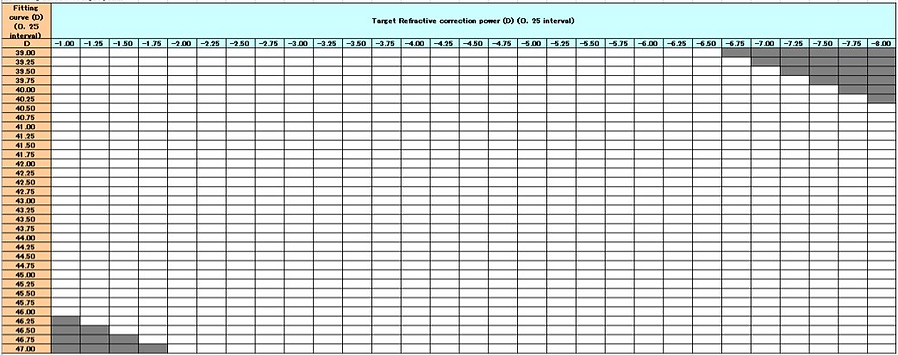FITTING STEPS

STEP 1 : SCREENING
EASY CALCULATION
-
Effectiveness is related to “Target Power” and “Shape of cornea”.
-
Generally, the higher the Target power is, the less effective it is.
-
Our recommended way to judge applicability is the calculation formula:
(Flatter meridian) - (Target power) ≧ 39.00
For example, if the Flatter meridian is 44.00 D, target power under -5.00 D

ESTIMATION FROM TOPOGRAPHY PATTERN
Applicable eyes that lens can be positioned in the center of the cornea
Recommendation : Breath-O Correct HD
> Patients who have heavy stress on cornea using BOC sphere
> Patients with high power ortho-K
> Fitting Curve (FT) : 39.00D ~ 47.00D (0.50D increment)
> Target Power (TP) : -4.50D ~ -8.00D (0.50D increment)
Note : Fitting pattern of BOC HD is the same as BOC sphere.
Please check the fitting pattern using the BOC sphere trial lens

STEP 2 : CHOICE OF 1ST TRIAL LENS - BOC Sphere
PHASE 1 : Determine the Fitting Curve referring to average of keratometery data.
PHASE 2 : Calculate the different between the Fitting Curve and the flattest meridian
PHASE 3 : Determine the Target Power by adding the difference (step 2)
PHASE 4 : Diameter is 10.6 mm ( standard diameter for trial lens)
DETERMINE THE FITTING CURVE (FT)
REFERRING TO AVERAGE OF KRT DATA
Fitting Curve ≒ AVG K (45.00)
Target Power = ?
Diameter = 10.6 (Standard Size)

DETERMINE THE TARGET POWER (TP)
CALCULATE THE DIFFERENCE BETWEEN FITTING CURVE & FLATTER MERIDIAN
Target Power ≒ S + (Flat K-Fit Curve)
Referring to KRT data:
Target Power =-4.50+(44.25-45.00) = -5.25
Final Target Power = -5.50*
*Adjusted by measuring the refractive power while wearing the lens.
1st Choice Trial lens as follow :
Fitting Curve (FC) = 45.00
Target Power (TP) = -5.50D
Diameter (D) = 10.6mm

> OVER REFRACTION
After fitting the appropriate trial lens , required additional power will be added on the trial lens Target Power.
Over Refraction ( Spherical Power) = 0.00 ~ +0.50D
* Measure the spherical power while wearing lens and check it is within +0.50D.
* More accurate values can be calculated by measuring over refreaction 30 ~45 minutes after wearing lens.

POSSIBLE RANGE TO ORDER
Fitting Curve Range
39.00D ~ 47.00D (0.50D increment stock range)
39.00D ~ 47.00D (0.25D increment pre-order range)
Target Power
-1.00D ~-8.00D (0.50D increment stock range)
-1.00D ~ -8.00D (0.25D increment pre-order range)
Lens Diameter
10.2 mm
10.6 mm [Standard Diameter]
11.0 mm

STEP 3 : FITTING CONDITION
-
Criteria for the fitting condition after 15 minutes of lens wear
-
Lens is proper centered.
-
Lens move 1~2 mm at blinking.
-
A proper doughnut pattern is achieved, and also the optical zone as wide as 3 mm.
-
Vision correction needed by patient should be obtained and stable, and wearing feeling is comfortable.
GOOD FITTING
-
Criteria for fitting condition after 15 minutes of lens wear
-
Lens is proper centered.
-
Lens move 1~2 mm at blinking.
-
A proper doughnut pattern is achieved, and also the optical zone as wide as 3 mm.
-
Vision correction needed by patient should be obtained and stable, and wearing feeling is comfortable.

TIGHT FITTING
-
narrow optical zone
-
less moving
-
insufficient tear exchange

LOOSE FITTING
-
the lower edge of the lens has clearance from the cornea
-
Loose moving
-
tear pass through the reverse curve (channelling)

Trouble-shooting with 0.25 step
STEP 4: Additional Correction




